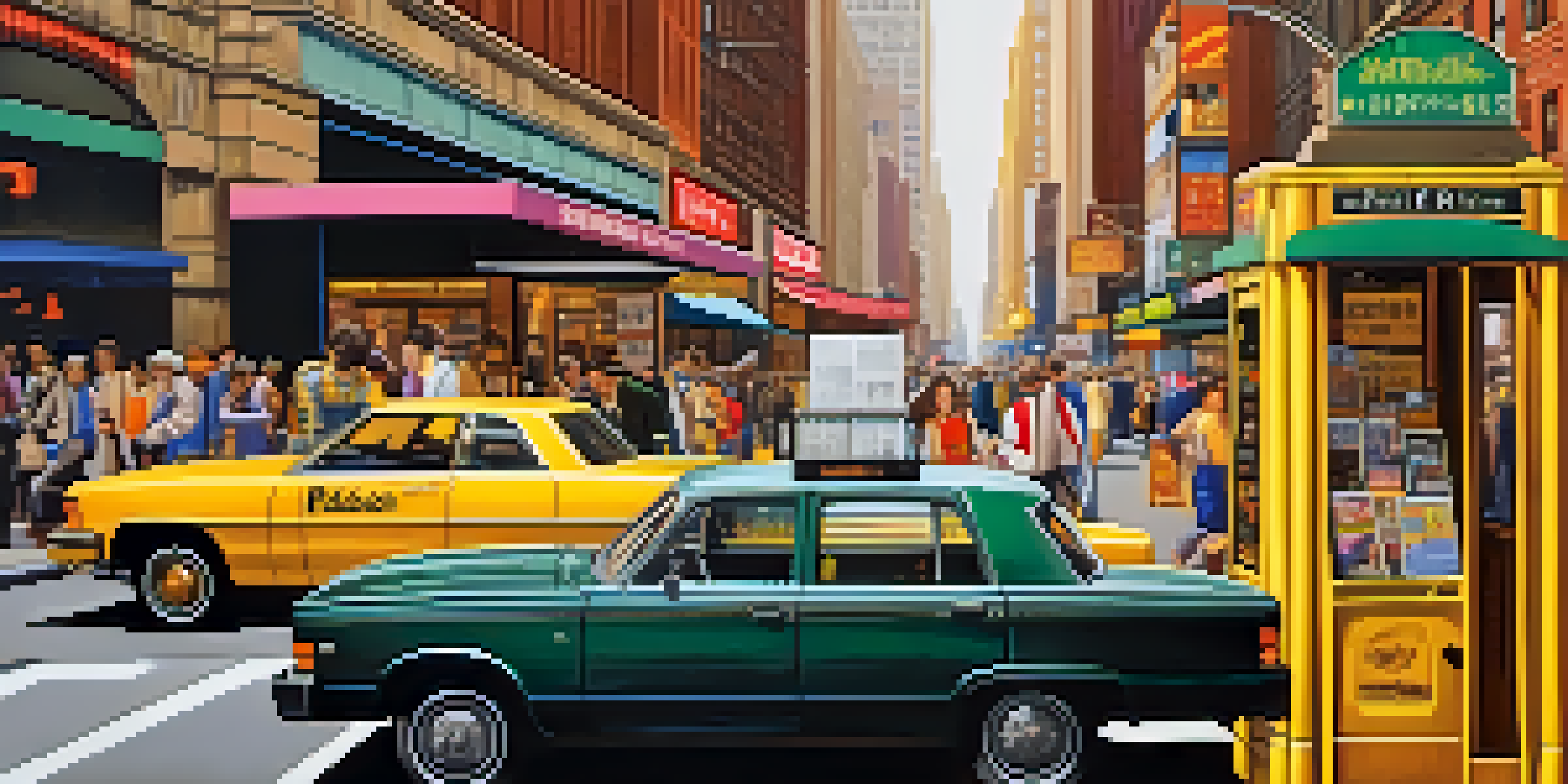The Evolution of Digital Media in New York City: A Timeline

The Dawn of Digital Media: 1990s in NYC
The 1990s marked the beginning of the digital media era in New York City. During this time, the internet started to emerge as a powerful tool, with AOL and other dial-up services connecting millions. New York's media landscape began to shift as traditional newspapers and magazines faced new competition from online platforms.
The way we consume media has fundamentally changed, and the rise of digital platforms has allowed for unprecedented access and engagement.
In this vibrant environment, many budding tech startups began to sprout, aiming to capitalize on the burgeoning online space. This was not just about content; it was about creating digital experiences that could engage audiences in new ways. As more people gained access to the internet, the foundation was laid for what was to come.
By the end of the decade, websites began to flourish, and media companies started investing heavily in their online presence. This shift set the stage for a digital revolution that would transform the way content was consumed, paving the way for innovations that followed.
Rise of Social Media: The 2000s Transformation
The 2000s brought an explosion of social media platforms, fundamentally changing how New Yorkers interacted with digital media. Websites like MySpace and Facebook emerged, allowing users to create profiles, share content, and connect with friends. This new social dynamic encouraged media companies to rethink their content strategies.

As social networks gained popularity, they began to influence the news cycle. Journalists and media outlets recognized the power of these platforms for distributing information and engaging with audiences. The ability to share stories instantly meant that local news could reach a wider audience than ever before.
Digital Media's Evolution in NYC
The transformation of digital media in New York City has evolved from the early internet days to the rise of social media and streaming services.
This decade also saw the rise of user-generated content, where ordinary New Yorkers became content creators. Blogs and platforms like YouTube allowed anyone with a story to tell to reach an audience, democratizing media and changing the landscape forever.
Mobile Revolution: 2010s and Beyond
With smartphones becoming ubiquitous in the 2010s, digital media in New York City underwent yet another significant transformation. Mobile apps emerged as crucial platforms for news consumption, allowing users to access information anytime and anywhere. This shift changed how media was produced, consumed, and shared.
In the world of social media, authenticity is key; people want to connect with real stories and real creators.
New York media companies quickly adapted to this trend by optimizing their content for mobile devices. They recognized that audiences preferred bite-sized, easily digestible content that could be accessed on-the-go. As a result, the focus shifted towards mobile-friendly formats, including podcasts and short videos.
Moreover, social media platforms optimized for mobile use, like Instagram and Snapchat, influenced how brands created and shared content. The emphasis was on visual storytelling, leading to a new era of creativity in digital media that remains influential today.
The Impact of Streaming Services: 2010s Onwards
As streaming services like Netflix and Hulu gained traction, the way New Yorkers consumed entertainment changed dramatically. Suddenly, binge-watching became a cultural phenomenon, and traditional cable television began to lose its grip. This shift not only affected viewers but also transformed the entire media production landscape.
Media companies in NYC had to adapt quickly, creating original content that could compete with streaming giants. New York became a hub for innovative series and documentaries, showcasing local talent and stories. This new focus on quality content helped redefine what audiences expected from digital media.
Influencers Redefine Content Creation
In the 2020s, influencers became key players in shaping marketing and content strategies, emphasizing authenticity and relatability.
Additionally, the rise of streaming services led to the emergence of new distribution models. Content creators began exploring various formats, from short web series to immersive virtual reality experiences, further diversifying the media landscape in the city.
The Role of Influencers: A New Breed of Creators
In the 2020s, influencers became a significant force in digital media, reshaping marketing and content creation. Based in New York City, many influencers leveraged their platforms to reach millions, creating a new form of celebrity. This shift highlighted the importance of authenticity and relatability in media.
Brands began to recognize the power of influencer partnerships, integrating them into their marketing strategies. Influencers could connect with audiences in a way that traditional advertising could not, often leading to higher engagement and trust. This approach transformed how products and services were marketed.
Moreover, influencers pushed the boundaries of content creation, experimenting with formats across various social media platforms. From TikTok dances to Instagram stories, their creativity has inspired a new generation of content creators who are redefining the media landscape in NYC.
The Future of Digital Media: Trends to Watch
As we look towards the future, digital media in New York City is poised for even more change. Emerging technologies like artificial intelligence (AI) and augmented reality (AR) are beginning to play a significant role in content creation and consumption. These advancements promise to create more personalized and immersive experiences for users.
Furthermore, there is a growing emphasis on sustainability and ethical media practices. Audiences are becoming more discerning, seeking out brands that align with their values and promote social responsibility. This trend is encouraging media companies to adopt more sustainable practices in both content creation and distribution.
Future Trends in Digital Media
Emerging technologies and ethical practices are set to further revolutionize digital media in New York City, promising personalized experiences and new monetization models.
Finally, the rise of decentralized platforms and the blockchain could revolutionize how digital media is monetized. This shift may empower creators, allowing them to retain more control over their work while providing new opportunities for innovative content distribution models.
Conclusion: The Ongoing Journey of Digital Media
The evolution of digital media in New York City is a testament to the city's resilience and innovation. From the early days of the internet to the rise of social media and streaming services, each phase has shaped the way we communicate and consume content. As technology continues to evolve, so too will the landscape of digital media.
New York City will undoubtedly remain at the forefront of these changes, fostering creativity and collaboration among diverse voices. The ongoing journey of digital media reflects broader societal shifts, making it essential to remain adaptable and open to new ideas.

Ultimately, the future of digital media in NYC holds endless possibilities, and as we navigate this dynamic landscape, one thing is clear: the story is far from over.